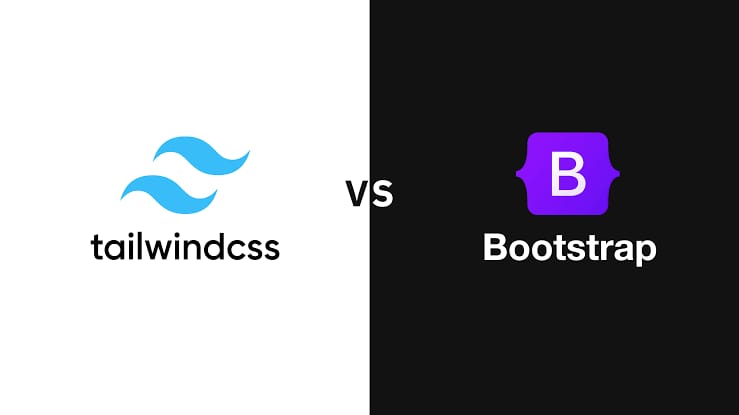Tailwind CSS vs. Bootstrap: History, Features, and Use Cases
 Anish Agrawal
Anish Agrawal
Tailwind CSS and Bootstrap are two of the most popular front-end CSS frameworks, each with its own distinct design philosophy and approach to styling. While Bootstrap revolutionized web development with its pre-built components and grid system, Tailwind CSS introduced a more flexible, utility-first approach. Let’s dive into their histories, key differences, and how they can work together.
History of Bootstrap
Bootstrap was created at Twitter by Mark Otto and Jacob Thornton and was initially released in 2011. It began as an internal tool to unify design inconsistencies within Twitter’s interface and was later open-sourced, quickly becoming one of the most popular front-end frameworks.
Component-based Framework: Bootstrap’s core appeal was its pre-built components like buttons, modals, and forms, which allowed developers to quickly build websites without writing custom CSS.
12-column Grid System: One of Bootstrap’s most influential contributions to web development was its responsive 12-column grid system. This grid made it easier to structure page layouts that worked across devices.
Sass and Customization: Later versions of Bootstrap introduced Sass support, making it easier to customize themes by overriding variables. Bootstrap 5 (released in 2021) also removed its jQuery dependency, modernizing the framework to keep up with performance improvements and evolving web standards.
History of Tailwind CSS
Tailwind CSS was released in 2017 by Adam Wathan, Jonathan Reinink, David Hemphill, and Steve Schoger as an answer to the limitations of component-based frameworks like Bootstrap. The creators of Tailwind wanted more flexibility in designing user interfaces without being constrained by predefined styles.
Utility-first CSS: Tailwind is a utility-first CSS framework, meaning it offers low-level utility classes like
p-4,text-center, andbg-blue-500that allow you to style elements directly in your HTML. This is in contrast to Bootstrap’s pre-designed components.Customization and Flexibility: Tailwind is highly customizable. It allows developers to define custom themes, colors, and spacings in its configuration file. Tailwind’s flexibility makes it ideal for projects requiring a unique look and feel, without the restrictions of pre-built UI components.
PurgeCSS Integration: Tailwind is optimized for performance through integration with PurgeCSS, which removes unused CSS classes from production builds, resulting in smaller file sizes.
Key Differences Between Tailwind CSS and Bootstrap
| Feature | Tailwind CSS | Bootstrap |
| Design Approach | Utility-first (low-level styling) | Component-first (pre-built UI elements) |
| Customizability | Highly customizable with configuration | Customizable, but within predefined limits |
| Grid System | Flex-based utilities (flex, grid) | 12-column grid system |
| Development Speed | Slower for small projects, faster in large, custom projects | Quick prototypes, slower for custom designs |
| CSS File Size | PurgeCSS reduces file size significantly | Larger out-of-the-box due to pre-built styles |
| Popularity | Growing popularity in custom design space | Widely used in quick prototypes and enterprise projects |
| Learning Curve | Steeper due to custom building | Easier due to ready-made components |
Use Cases for Each Framework
When to Use Tailwind CSS:
Custom Design Requirements: If your project requires unique, custom styles without the limitations of pre-designed components, Tailwind’s utility-first approach gives you full control over the design.
Scalability and Performance: Tailwind’s integration with PurgeCSS allows you to minimize the size of your final CSS, making it ideal for large-scale applications where performance is key.
Flexibility: Tailwind excels in flexibility and can easily adapt to different design systems or custom-built UIs.
When to Use Bootstrap:
Rapid Prototyping: If you need to quickly build a responsive website with minimal design requirements, Bootstrap’s pre-built components allow you to set up a website in no time.
Consistency and Standardization: For projects that prioritize consistency, especially in large teams, Bootstrap provides a standardized design system that everyone can follow.
Familiarity: Bootstrap is widely adopted, making it easy for teams or clients already familiar with it to jump into a project.
Using Tailwind CSS with Bootstrap
While Tailwind CSS and Bootstrap are distinct in their approaches, it is possible to use both together, but it comes with some challenges:
Class Name Conflicts: Both frameworks use similar class names (e.g.,
container,hidden). These conflicts can be managed using Tailwind’simportantmode or by namespacing Bootstrap.Utility for Customization: You can use Bootstrap’s components for faster development and supplement them with Tailwind’s utility classes for more granular control over styling. For instance, use Bootstrap’s grid system and modals while using Tailwind for padding, margins, and custom text styling.
Optimization: To avoid bloat, use PurgeCSS to remove unused styles from Tailwind and Bootstrap. This will help keep the final bundle size manageable.
Which Framework Should You Choose?
The decision between Tailwind CSS and Bootstrap depends on your project’s needs:
Choose Tailwind CSS if you want total control over your design and are willing to spend time crafting custom layouts.
Choose Bootstrap if you need to build quickly with pre-made components and don't want to spend much time customizing the UI.
For projects that require both rapid development and customization, you can combine the strengths of both frameworks, although this may require extra work to resolve conflicts and manage file sizes.
Summary:
Bootstrap brought web development into the responsive era with its component-based design and grid system in 2011.
Tailwind CSS emerged in 2017 as a more flexible, customizable alternative with a utility-first approach.
The choice between Tailwind and Bootstrap comes down to speed vs. customization.
Subscribe to my newsletter
Read articles from Anish Agrawal directly inside your inbox. Subscribe to the newsletter, and don't miss out.
Written by
